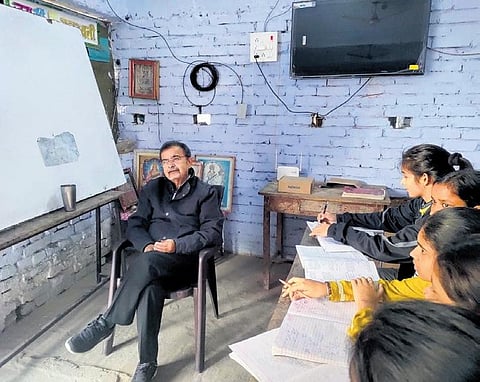Youths from Bihar’s Naxal-affected villages break the vicious cycle
BIHAR: Gone are the days when Maoist leaders were role models for the youth in the Gaya and Aurangabad districts in Bihar, as the grooming of local talent has brought a significant change in the region. Though several youngsters have set an example by clearing the prestigious IIT entrance and civil services examinations earlier, the story of IITian Sandeep Kumar is nothing short of an inspiration.
Sandeep cleared the civil services examination this year and secured the 697th position, standing as a ray of hope for youths living in the Naxal-infested areas of Gaya, Aurangabad and adjoining Arwal.
Only a few years ago, locals, who had grown up listening to the purportedly ‘valiant actions’ of Maoist leaders, looked up to them as role models.
Sandeep, a native of Dumaria in the Gaya district, is perhaps the first IITian of his locality, setting an example for other youths who started making efforts to emulate him. Coming from a family that runs a small shop in the village, Sandeep joined IIT, Mumbai and completed his B. Tech in mechanical engineering.
He said he had to face a lot of issues while studying at a local school. The village has no road connectivity and electricity was more often than not an obstacle. Calls for ‘bandh’ (shutdown) by Maoists against police action was another big challenge, he remarked.
AURANGABAD, IIT DELHI
Sandeep said that his father and grandfather had died when he was studying in IIT Delhi which was an insurmountable loss for him. But then he remembered how both questions and counter questions put by former Bihar DGP Abhayanand during his preparations for IIT JEE at Super 30 were important, cementing his resolve.
Similarly, having fought against all odds, Renu Kumari from Goh in Aurangabad district is studying at IIT Delhi. Earlier, another student from the Naxal-dominated area, Vikram emerged as a source of inspiration for youths by getting admission into IIT, Roorkee. Both were students of Abhayanand’s Super 30.
The list of young achievers from the Maoist-dominated areas continues to grow as Sonu Gupta and his sister Rupa Kumari got admissions into IIT, Delhi. They are natives of Pakriguria in Banke Bazar in Gaya district.
More than a dozen students including Soni Rashmi from Barwadih village under Dumaria block are now studying in various technical institutes, changing the attitude of several other students in the area towards their lives.
With students shining in the academic field, extremist organisations found it tough to find new recruits in the children and women squads. Maoists used them, who were their cadres, as a shield to protect themselves from security personnel during operations.
Along with several initiatives taken by the Centre as well as the state government, Super 30 also played a big role in weaning away youths from the path of Naxalism and motivated them to excel in their lives by focusing on their studies.
Another youth who aced his long journey to success is Gaurav Kumar, a native of Laxmanpur Bathe village in Naxal-hit Arwal district. The village had hit the headlines when 62 members of the Dalit community were killed by Ranvir Sena, a private militia of landlords, on December 1, 1997.
Gaurav secured 789th rank in the civil services examination conducted by Union Public Service Commission (UPSC), the result of which was declared in the last week of May this year. Gaurav’s selection in civil services is certainly a silver lining for other youth of Maoist-infested villages in the district.
Recalling his childhood in his native village, Gaurav said, “I have heard the story of bloodshed in the village by my father Sanjeev Kumar, a farmer. Scores of people were killed in the caste conflict between Dalits and members of other communities in the village. But things have changed now.”
Laxmanpur Bathe, once considered to be a nerve centre of Maoists, will soon be able to change the stigma attached to it.
GAYA, IIT DELHI
“Several youths of the village are preparing for top-level competitive examinations and they will succeed. The village, known for its bloodiest caste killings will be known for their talents,” Gaurav asserted.
Likewise, Rajesh Kumar Gupta, a resident of Deo block in Aurangabad district, sacrificed comforts to get his two sons selected for IIT. Gupta runs a grocery shop in his native village.
According to Bihar police, Gaya, Aurangabad and Arwal are among the worst Maoist-hit districts in the state.
Additional director general of police (headquarters) Jitendra Singh Gangwar said, “The situation is not as bad as it used to be earlier. Police action is very quick, which has restored the faith of people in men in uniform.”
Bihar’s eight districts—Gaya, Aurangabad, Nawada, Sheikhpura and Jamui districts—contributed to the majority of the Naxal-related incidents in Bihar.
Pramod Mishra, a bureau member of the Naxal outfit—CPI (Maoist), was arrested last week from Gaya. He is facing charges for more than two dozen cases related to Maoist incidents in Aurangabad and Gaya districts. On the contrary, Mishra’s son Suchit Mishra is busy educating children belonging to Maoist-hit villages in the Aurangabad district. Suchit, whose house is frequently searched by police and other investigating agencies, runs a school in Aurangabad.

